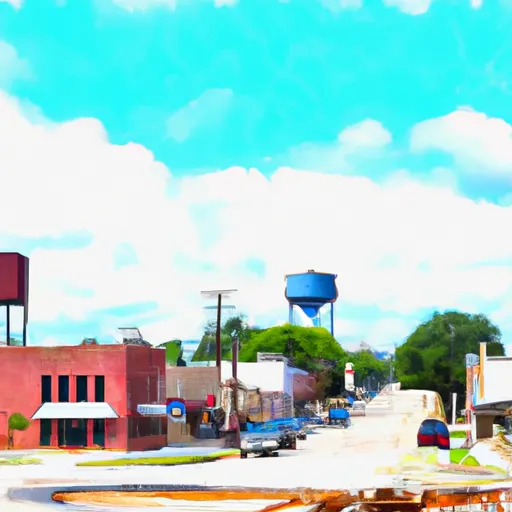-
 Snoflo Premium
Snoflo Premium
Get unlimited access to all our content
With no Ad interruptions! - Start Your Free Trial Login with existing account
Navasota
Eden Index
Climate
8.2
•
Recreation
3.1
•
Community
2.1
•
Safeguard
4.9/10

Navasota is a small city located in Grimes County, Texas. It experiences a humid subtropical climate characterized by hot summers and mild winters. Average temperatures range from 40°F (4°C) in winter to 95°F (35°C) in summer, with occasional extreme temperature fluctuations. The area receives around 43 inches of rainfall per year, evenly distributed throughout the seasons, which supports its lush vegetation and diverse wildlife.
Navasota is surrounded by beautiful natural landscapes, including the Navasota River, which flows through the city. The river provides opportunities for various outdoor activities such as fishing, boating, and canoeing. The region is also known for its numerous parks and nature trails, offering hiking and biking opportunities. The Grimes County State Park is a popular spot for camping, picnicking, and wildlife observation.
Furthermore, Navasota is situated close to the Sam Houston National Forest, offering additional outdoor recreational activities such as hunting, bird-watching, and camping. The forest's numerous trails are perfect for hiking and horseback riding. With its favorable climate, stunning waterways, and abundant natural areas, Navasota provides residents and visitors with plenty of opportunities to enjoy the outdoors.
What is the Eden Index?
The Snoflo Eden Index serves as a comprehensive rating system for regions, evaluating their desirability through a holistic assessment of climate health, outdoor recreation opportunities, and natural disaster risk, acknowledging the profound impact of these factors on livability and well-being.
Climate Health Indicator (CHI): 8.2
Navasota receives approximately
1064mm of rain per year,
with humidity levels near 83%
and air temperatures averaging around
20°C.
Navasota has a plant hardyness factor of
8, meaning
plants and agriculture in this region tend to thrive here all year round.
By considering the ideal temperature range, reliable water supplies, clean air, and stable seasonal rain or snowpacks, the Climate Health Indicator (CHI) underscores the significance of a healthy climate as the foundation for quality living.
A healthy climate is paramount for ensuring a high quality of life and livability in a region, fostering both physical well-being and environmental harmony. This can be characterized by ideal temperatures, reliable access to water supplies, clean air, and consistent seasonal rain or snowpacks.
Weather Forecast
Streamflow Conditions
Lower Brazos
Area Rivers
Lower Brazos
Snowpack Depths
Lower Brazos
Reservoir Storage Capacity
Lower Brazos
Groundwater Levels
Recreational Opportunity Index (ROI): 3.1
The Recreational Opportunity Index (ROI) recognizes the value of outdoor recreational options, such as parks, hiking trails, camping sites, and fishing spots, while acknowledging that climate plays a pivotal role in ensuring the comfort and consistency of these experiences.
Access to outdoor recreational opportunities, encompassing activities such as parks, hiking, camping, and fishing, is crucial for overall well-being, and the climate plays a pivotal role in enabling and enhancing these experiences, ensuring that individuals can engage in nature-based activities comfortably and consistently.
Camping Areas
| Campground | Campsites | Reservations | Toilets | Showers | Elevation |
|---|---|---|---|---|---|
| Stephen Austin State Park | 78 | 135 ft | |||
| Oyster Lake County Park Dispersed | None | 1 ft | |||
| Riverside Park - Bay City | 40 | 34 ft | |||
| Navasota RV Park | 10 | 221 ft | |||
| Gibbons Creek Reservoir | 27 | 255 ft | |||
| Purtis Creek State Park | 78 | 424 ft | |||
| Fairfield Lake State Park | 135 | 382 ft | |||
| Hollywood Bottom Park | None | 74 ft | |||
| Carl Park | None | 3 ft | |||
| FM 521 River Park | None | 20 ft |
Nearby Ski Areas
Catastrophe Safeguard Index (CSI):
The Catastrophe Safeguard Index (CSI) recognizes that natural disaster risk, encompassing floods, fires, hurricanes, and tornadoes, can drastically affect safety and the overall appeal of an area.
The level of natural disaster risk in a region significantly affects safety and the overall livability, with climate change amplifying these risks by potentially increasing the frequency and intensity of events like floods, fires, hurricanes, and tornadoes, thereby posing substantial challenges to community resilience and well-being.
Community Resilience Indicator (CRI): 2.1
The Community Resilience Indicator (CRI) recognizes that education, healthcare, and socioeconomics are crucial to the well-being of a region. The CRI acknowledges the profound impact of these elements on residents' overall quality of life. By evaluating educational resources, healthcare accessibility, and economic inclusivity, the index captures the essential aspects that contribute to a thriving community, fostering resident satisfaction, equity, and social cohesion.

